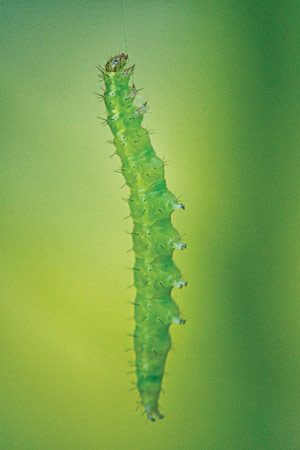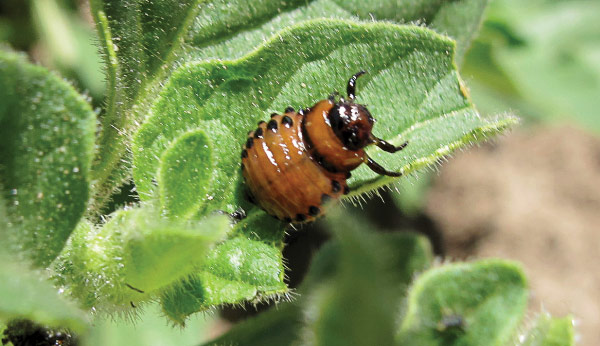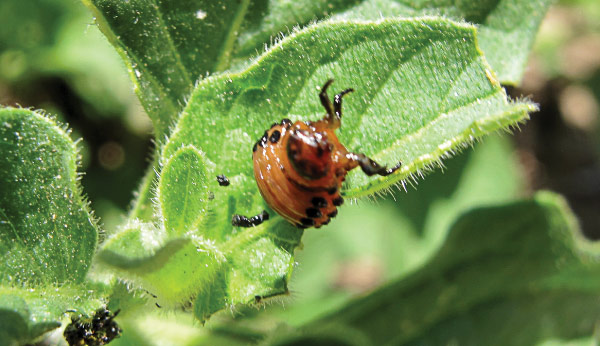Incorporating Insect Fear in Integrated Pest Management
 |
|
When they encounter a predator, diamondback moth larvae drop and dangle themselves from a silk thread, climbing back to leaves when danger has passed. Photo by Fitz Clarke, flic.kr/p/rjSsd7, used with permission. |
By Ricardo Ramirez, Extension Entomologist
A version of this article first appeared in the winter 2019 issue of the Utah Pests Quarterly newsletter.
Predatory insects and parasitoids provide natural pest control by directly feeding on pests. An overlooked aspect of these beneficial insects that has gained attention in pest management is that they do not necessarily need to eat a pest to have an impact.
Predator Impacts on Pest Behavior
In the face of a predator, your behavior changes, whether it is an intense feeling to want to flee, freeze in place, or just crap yourself. It turns out that predators affect rodent prey even when they are not present, as their urine provides enough of a cue for rodents to scurry and hide. In agriculture, the threat of predation on insects is an emerging area being recognized as a component of biological control, given that threats, or “fear,” can reduce pest damage to plants.
Pest insects detect predators by seeing them, identifying specific odors, and sensing vibrations from movement or sound. Pest responses toward predators vary widely but can involve changes in pest behavior.
Billbugs: A Case Study in Control by Fear
 |
 |
|
Colorado potato beetle larvae display several defensive behaviors toward predators including wiggling, regurgitating digested plant juices, and rearing their heads upward and flailing their front legs. |
In a recent article in the journal Biological Control, Dr. Madeleine Dupuy, former Utah State University (USU) biology graduate student, determined to what extent predatory ground beetles and wolf spiders fed on various billbug life stages in turfgrass, and how these predators impacted billbug behavior.
Despite evidence that predatory ground beetles and spiders are capable of feeding on a variety of pest species, these predators posed little risk to adult billbugs, with only approximately six-percent predation. Billbug eggs were readily eaten by predatory ground beetles, but lab tests found that larval stages were less likely to be eaten when larvae were at least one centimeter deep in the soil.
Given that these predators did not consume adult billbugs or larvae within soil, we might tend to think that they are not providing effective biological control. However, Dupuy’s research also found that when adult billbugs were in the presence of predators, they reduced their mating activity and egg-laying, and spent time playing dead. These behaviors diverted the pest from feeding on the turf.
Current USU biology graduate student Desireè Wickwar has followed up on Dupuy’s research and has begun evaluating the effect of predator odor on billbug behavioral changes. Preliminary observations show that predator odor alone can alter adult billbug behaviors, and research is ongoing.
Can fear behavior result in less plant damage?
Research has shown that predator-avoidance behaviors can have major implications for the insect pests’ fitness, and these effects can be just as strong as the direct consumption of pests.
Colorado potato beetles that were exposed to damsel bugs and other predators flail their front legs, regurgitate, walk away, and defecate. All of these behaviors detract the beetles from feeding on the plants.
Pea aphids that were exposed to predators dropped from plants, exposing them to other mortality factors, and also increased the number of wing-formed offspring as compared to aphids not exposed to predators.
Japanese beetles placed on leaves containing spider silk reduced their feeding as compared to beetles on untreated leaves or on leaves treated with other natural and artificial fibers.
Exploring and Quantifying the Benefits of Fear
There is still a need to know which predator species has what intimidation level in the same way we evaluate the amount of prey any one predator species can consume. As research continues on this front, with evidence that just the predator cues can alter pest behavior, there may be clever ways of isolating and using predator cues or materials in pest management.
Insects’ fear toward predators is a less-obvious form of biological control than actually being consumed by a predator. It is important to recognize the behaviors of pest insects in avoiding predators and how they can have a negative impact on pests and assist in preventing plant damage, even to the level of direct predator consumption.
This emphasizes the point that conserving predators is even more important, given these additional ways they affect pests.
For More Information
Aflitto, N., and J. Thaler. 2016. Fear as a biological control? How scaring farm and garden pests could lessen plant damage. New York State IPM Program. Vegetables IPM Fact Sheet No. 45068.
Dupuy, M. M., and R. A. Ramirez. 2018. Consumptive and non-consumptive effects of predatory arthropods on billbug (Coleoptera: Dryophthoridae) pests in turfgrass. Biological Control 129: 136–147.
Ferrero, D. M., et al. 2011. Detection and avoidance of a carnivore odor by prey. PNAS 108: 11235–11240.
Ramirez, R. A., et al. 2010. Antipredator behavior of Colorado potato beetle larvae differs by instar and attacking predator. Biological Control 53: 230–237.
The Northeastern IPM Center promotes integrated pest management for reducing risks to human health and the environment. If republishing our news, please acknowledge the source (“From Northeast IPM Insights”) along with a link to our website.
